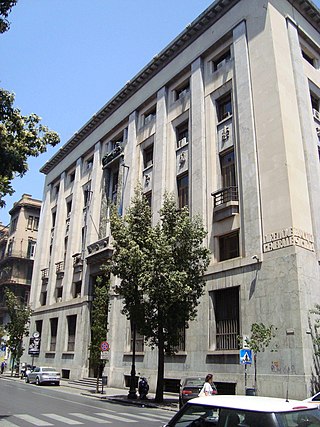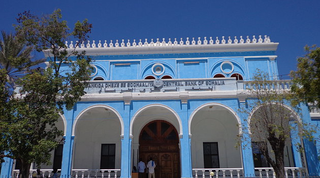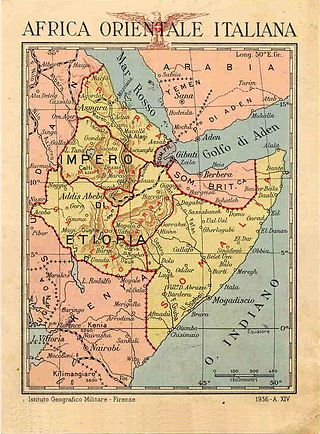Related Research Articles

The Bank of Italy is the Italian member of the Eurosystem and has been the monetary authority for Italy from 1893 to 1998, issuing the Italian lira. Since 2014, it has also been Italy's national competent authority within European Banking Supervision. It is located in Palazzo Koch, via Nazionale, Rome.

The Italian East African lira was a special banknote circulating in Italian East Africa between 1938 and 1941.

The Commercial Bank of Ethiopia (CBE) is the largest commercial bank in Ethiopia. As of June 2021, it had about 1.1 trillion birr in assets and held approximately 67% of deposits and about 53% of all bank loans in the country. The bank has around more than 35,000 employees as of June 2022, who staff its headquarters and its over 1000+ branches positioned in the main cities and regional towns. The latter include 120 branches in the national capital Addis Ababa. With the opening of a branch in the Gechi in the Illubabor Zone, CBE's banking network has reached online 783 branches. The bank has reached more than 1950 branches as of 10 August 2022.

Banca per l’Africa Orientale (BAO) was an early attempt to establish modern banking in the Horn of Africa at a time when Eritrea and Italian Somaliland were Italian colonies. It closed in 1923.

Banco di Sicilia was an Italian bank based in Palermo, Sicily. It was a subsidiary of UniCredit but absorbed into the parent company in 2010.

The Central Bank of Somalia (CBS) is the monetary authority of Somalia. Somalia has struggled to reestablish a functioning state since the collapse of an authoritarian regime in 1991. Somalia has been cited as a real-world example of an anarchist stateless society and a country with no formal legal system. The Transitional Federal Government, formed in 2004, was recognized as the central government of Somalia. Among other duties, it is in charge of ensuring financial stability, maintaining the internal and external value of the local currency, and promoting credit and exchange conditions that facilitate the balanced growth of the national economy. Within the scope of its powers, it also contributes to the financial and economic policies of the State.

Credito Italiano, often referred to by the shorthand Credit, was a significant Italian bank based in Milan. It was established in 1895, succeeding the Banca di Genova established in 1870 in Genoa. In 1998 it merged with Unicredito to form Unicredito Italiano, later known as UniCredit.

Banca Commerciale Italiana, founded in 1894, was a major Italian bank based in Milan. In 1999, it merged with the group recently formed by the combination of Cassa di Risparmio delle Provincie Lombarde and Banco Ambroveneto to form IntesaBCI, in which BCI temporarily became a sub-holding company. On 1 January 2003, the group's name changed to Banca Intesa, later Intesa Sanpaolo.

Italian Eritrea was a colony of the Kingdom of Italy in the territory of present-day Eritrea. The first Italian establishment in the area was the purchase of Assab by the Rubattino Shipping Company in 1869, which came under government control in 1882. Occupation of Massawa in 1885 and the subsequent expansion of territory would gradually engulf the region and in 1889 the Ethiopian Empire recognized the Italian possession in the Treaty of Wuchale. In 1890 the Colony of Eritrea was officially founded.

Eritrea Governorate was one of the six governorates of Italian East Africa. Its capital was Asmara. It was formed from the previously separate colony of Italian Eritrea, which was enlarged with parts of the conquered Ethiopian Empire following the Second Italo-Ethiopian War.

Banco di Roma was an Italian bank based in Rome, established on 9 March 1880. In the early 20th century, it was one of Italy's four dominant universal banks, together with Banca Commerciale Italiana, Credito Italiano, and Società Bancaria Italiana. It developed a significant network throughout the Eastern Mediterranean and Italian Africa. In 1992 it eventually merged with the Banco di Santo Spirito and altered its name to Banca di Roma, later part of UniCredit.
Banca Popolare di Bari S.C.p.A., now BdM Banca, is an Italian bank based in Bari, Apulia region. The bank covered most of mainland Italy, except Piedmont and Liguria, and all the autonomous regions of Italy: Aosta Valley, Trentino – South Tyrol, Friuli – Venezia Giulia and the islands of Sardinia and Sicily.
Banco Popolare Siciliano is a brand used by Banco Popolare in Sicily.
Cassa Padana Banca di Credito Cooperativo S.C. is an Italian bank based in Leno, Lombardy. The bank served the area around Brescia and 8 other provinces of northern Italy.
Banca Popolare di Puglia e Basilicata S.C.p.A. is an Italian cooperative bank based in Altamura, in the province of Bari, Apulia region.

Banca di Credito Popolare S.C.p.A. (BCP) is an Italian cooperative bank based in Torre del Greco, in the Metropolitan City of Naples. Most of the clients of the bank are from the same area, in which the bank has 44 branches.
Banca Popolare Pugliese S.C.p.A. (BPP) is an Italian cooperative bank based in Parabita and Matino, in the province of Lecce, Apulia region.
Banca Popolare del Molise was an Italian bank based in Campobasso, Molise.
Cassa di Risparmio di Verona, Vicenza, Belluno e Ancona, also known by the shorthand Cariverona, was an Italian savings bank headquartered in Verona. It was formed in 1825 from a division of the Monte di Pietà di Verona, itself founded in 1490.

The National Bank of the Kingdom of Italy, known from 1850 to around 1870 as the National Bank of the Sardinian States, was a bank of issue of the Kingdom of Sardinia then the Kingdom of Italy after unification in 1861. Despite its name, it had no monopoly on money issuance, in a financial system that proved prone to instability. It was successively headquartered in Genoa (1850-1853), Turin (1850-1865), Florence (1865-1873), and Rome (1873-1893). Following the controversial failure of Banca Romana, the National Bank was eventually merged with several peers in 1893 to form the Bank of Italy.
References
- ↑ Tuccimei, Ercole:La banca d'Italia in Africa, Laterza, Bari, 1998
- ↑ Mauri, Arnaldo (2004): "Eritrea's early stages in monetary and banking development", International Review of Economics, Vol. LI, n. 4.
- ↑ Mauri, Arnaldo, Dept. of Economics, University of Milan, WP, n. 28-2003.
- ↑ Rena, Ravinder (2007): "Historical development of money and banking in Eritrea from the Axumite Kingdom to the present", African and Asian Studies, Vol. 6, N°. 1-2.
- ↑ Mauri, Arnaldo (1967): Il mercato del credito in Etiopia, Milano, pp. 261-171.
- ↑ Mauri, Arnaldo (1967):Il mercato del credito in Etiopia, pp. 405, 406.
- ↑ "IMF Executive Board Concludes Article IV Consultation with Eritrea". 2005-02-09. Archived from the original on 6 September 2006. Retrieved 2006-09-07.
- ↑ "Housing and Commerce Bank of Eritrea: Branches". Archived from the original on 29 September 2006. Retrieved 2006-08-30.
- ↑ "General Financial Sector Overview". Archived from the original on 2007-09-28. Retrieved 2006-08-30.